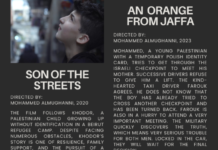Nour Khalil Khattab
The Electronic Intifada / November 23, 2024
Over the past year, Israel has repeatedly targeted historical and cultural landmarks in the Gaza Strip in what appears a deliberate attempt at erasing Gaza’s rich heritage.
The Greek Orthodox Church of Saint Porphyrius, named after the first bishop of Gaza who is said to be buried in the courtyard, was bombed soon after the Israeli military attacks began in October 2023.
I visited this church in Al-Zaytoun neighbourhood of the old city of Gaza in years past and always marvelled at its tall stained-glass windows, which reflected the light in a way that can only be described as inducing a sense of spirituality.
The windows are adorned with religious depictions of saints and scenes from the Bible and with icons illustrating the ancient and modern history of Gaza.
The church dates back to the 5th century and is one of the oldest in the world. It boasts traditional Byzantine architecture consisting of a square structure with a domed roof. At its center is an apse topped by a large dome with a cross.
The church is an integral part of the religious fabric of Gaza. It has served as a center for worship and reflection, a beacon of hope amid so much chaos for the Christian community.
During the current Israeli genocide, hundreds of Palestinians from various faiths have sought refuge within its this stone walls. That has not stopped Israel’s military from attacking the church, however, and the church has sustained heavy damage, including the destruction of many relics and artifacts that date back more than 1,500 years.
Targeting Gaza’s cultural heritage
I believe that the targeting of the church was not accidental. I believe it is part of Israel’s genocidal violence, a deliberate attack on the identity of an entire community.
The Church of Saint Porphyrius has been more than just a place of worship and a house of prayer. It has been a central hub for Gaza’s small Christian community and has borne witness to a rich history of diverse civilizations that have come and gone over the last 16 centuries.
In modern times, the church was a gathering place for people of different faiths, building bridges between Christians and Muslims, and fostering unity among Gaza’s inhabitants. It has hosted local celebrations and events for both religious and social activities.
The destruction of cultural and historical treasures is a profound loss not only to Palestinians in Gaza but to humanity itself. Every missing stone, every lost manuscript, every shattered window is an erasure of a piece of the collective memory of our common humanity. History is being erased from the hearts and souls of people.
The Israeli assaults have not been limited to Christian landmarks, of course. According to local authorities Israel has bombed 79 percent of all mosques in the territory. Museums and cultural centers have also been targeted.
There was Al-Bashir Mosque in Deir al-Balah, which stood in the middle of a residential block, and was obliterated in April along with the entire neighbourhood, leaving behind numerous dead and injured people.
Al-Qarara Cultural Museum in Khan Younis was destroyed, as was the Rashad al-Shawa Cultural Center in Gaza. The list is long and suggests a deliberate targeting of Gaza’s cultural heritage.
“The crime of targeting and destroying archaeological sites should spur the world and UNESCO into action to preserve this great civilisational and cultural heritage,” Gaza’s Ministry of Tourism and Antiquities said in a statement after the Great Omari Mosque was nearly completely destroyed in an Israeli air strike on 8 December.
The Omari mosque, 1,400 years old and one of the largest in Gaza City, had historical significance dating back to the early Islamic period. Only its minaret has been left intact.
Preservation
The loss of such irreplaceable treasures – whether ancient artifacts, historical landmarks or cultural centers – represents more than just the destruction of objects. It’s an erosion of humanity’s shared identity, history and values. These treasures tell stories of who we are, where we’ve come from, and the lessons we’ve learned.
The preservation of these symbols is not merely a local responsibility; it is a global duty that demands immediate action before the remnants of our shared history fade beyond recovery.
The ruins of these sacred spaces and the artifacts they housed is more than just a material loss. The items being destroyed are pieces of a shared global heritage, which tells the stories of civilizations, of faith, of the human spirit’s endurance across centuries. When such landmarks are obliterated, a part of the entire human story is silenced forever.
The Church of Saint Porphyrius, along with countless other cultural and religious treasures in Gaza, may stand in ruins today, but they also stand as a testament to the unshakable spirit of a people who refuses to be erased.
It is incumbent upon the international community to acknowledge this cultural vandalism for what it is – an attack on the collective memory of humanity.
Without action, the sands of time will cover the remnants of these monuments, and future generations will be left to wonder what stories were lost, or, worse, remain in unconscious ignorance that they ever existed.
Now more than ever, we must act to preserve the heritage that defines us, before it is wiped from the face of the earth.
Nour Khalil Khattab is a journalist and translator in Gaza












